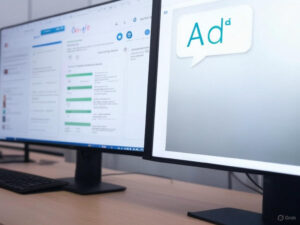Google Ads in AI Chatbots: What Every AI User in India Should Know
Table of Contents
-
Introduction
-
Why Is Google Adding Ads to AI Chatbots?
-
How Will These Ads Work?
-
What Changes for AI Users?
-
Concerns for Everyday Users
-
The Future of AI Chatbots and Advertising
-
Final Thoughts
1. Introduction
If you use AI chatbots like ChatGPT, Claude, or Perplexity, you probably enjoy clean, ad-free conversations. But big changes are coming! Google has started putting ads directly inside AI chatbot chats, not just on search pages or websites426. This move could change how we use AI tools in India and around the world.
2. Why Is Google Adding Ads to AI Chatbots?

-
Fewer People Using Google Search: As more people use AI chatbots for answers, Google’s search engine is getting fewer queries. This means less money from search ads, which is a huge part of Google’s business145.
-
Protecting Revenue: To keep earning, Google wants to show ads wherever people are asking questions-including inside AI chats14.
-
Staying Ahead: With new AI tools becoming popular, Google is making sure it doesn’t fall behind in the digital ad market16.
3. How Will These Ads Work?
-
AdSense for Search Expansion: Google’s AdSense for Search program now lets websites and chatbots show ads during AI conversations26.
-
Tested with Startups: Google first tested this with AI chatbots like iAsk and Liner. Now, any chatbot or website can join in26.
-
Blending In: Unlike banners or pop-ups, these ads are designed to look like part of the conversation-helpful, relevant, and less obvious, but still commercial43.
4. What Changes for AI Users?

-
Chatbots May Show Sponsored Answers: When you ask a chatbot for advice or information, you might start seeing suggestions or links that are actually ads43.
-
Ads Will Feel Like Chat: These ads won’t look like traditional ads. They’ll be woven into the chat, making it harder to tell what’s sponsored and what’s not43.
-
More Chatbots Will Have Ads: Any AI app or website can now choose to show these ads, so you might notice them in many different places soon26.
5. Concerns for Everyday Users
-
Trust Issues: When ads look like normal chatbot replies, it’s tough to know if you’re getting unbiased help or a paid suggestion. This can make users lose trust in AI answers34.
-
Transparency: If chatbots don’t clearly mark which replies are ads, users may feel misled. This blurring of lines is a big worry for people who rely on AI for genuine advice34.
-
User Experience: Ads could interrupt the smooth flow of conversation, making chats feel less natural and more commercial3.
-
Privacy: More ads mean more data tracking. How much of your chat data will be used to target ads? This is a question every user should ask3.
6. The Future of AI Chatbots and Advertising

| Aspect | Before (Now) | After Google’s Move |
|---|---|---|
| Ads in Chatbots | Rare or None | Common and Seamless |
| User Experience | Clean, Unbiased | Possible Commercial Bias |
| Transparency | High | Could Decrease |
| Data Privacy Concerns | Lower | Likely to Increase |
-
Other Companies May Follow: Google is setting a trend. If this works, other tech giants might also put ads in their AI chatbots43.
-
Possible Subscription Models: Some AI apps might offer ad-free experiences for a fee, while free versions show ads5.
-
Regulatory Watch: As ads blend into conversations, governments and regulators may step in to ensure user rights and fair practices36.
7. Final Thoughts
As an Indian blogger who has seen many tech trends come and go, I feel this is a big turning point for AI users. Right now, we enjoy ad-free, honest conversations with AI. But soon, ads will be part of our chats, sometimes in ways we may not even notice.
My concern: If you use AI chatbots for important advice-health, finance, education-be extra careful. Always check if the answer is sponsored or truly unbiased. Demand transparency from AI providers. And remember, your trust and data are valuable.
1 thought on “Google Ads in AI Chatbots: What Every AI User in India Should Know”